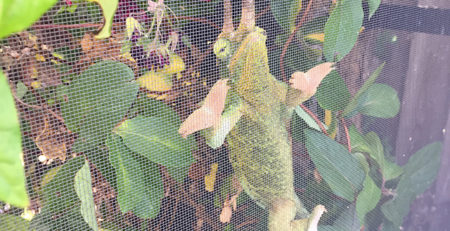Keeping Chameleons Together
Keeping Chameleons Together

Co-Habitation is when we have two or more chameleons sharing the same space. The question of whether co-habitation is an acceptable part of chameleon husbandry has been asked since the beginning of chameleon keeping. Because the concept of solitary living is so foreign to humans in general, it will continue to be asked forever. So we will delve deeply into it.
Chameleons arefound together in the wild. They do have a communication structure and social interaction. This is natural for them to have and if we are are being dedicated to reconstructing their natural conditions then social interaction would be one of those components. The challenge is that you cannot go half way. Part of chameleon communication is the ability to physically get away from each other. If you cannot give this ability (which is what a cage removes) then it is disaster to allow them to start the conversation. Imagine if a human couple was put into a room to live out their lives and any communication pertaining to “I am sorry” or “you are right” was removed from their ability. There will soon come a time when they will not be living harmoniously.
There are a number of main reasons keepers want to put chameleons into the same cage.
Appearance and Collecting. Wouldn’t it be cool to have a slice of the jungle in our living rooms? For some people, a slice of the jungle means animals constantly crawling in and out of view. With lots of chameleons in a single cage there is always something to see! Or else you want three species of chameleons and love the variety in your cage. There will be many variations on these reasons. They boil down to the keeper wanting to create a certain experience for themselves. This is not wrong in itself. In fact, it is important that you create the chameleon keeping experience in a way that is enjoyable to you. But you must also create it in a way that is healthy for your chameleon. If you want more than one chameleon then just get more than one cage.
My Chameleon will get lonely. This is the reason given by keepers new to chameleons. They want to do anything and everything to keep their chameleon happy! A friend for your chameleon seems a reasonable way to make sure it stays happy.
First, let’s set some background. We humans are pack animals. We create communities and groups. It is hardwire programmed in us that having others around us is safety and, therefore, gives us comfort. We share this trait with dogs, parrots, and many other animals that form packs or flocks or schools. These animals can make very good pets as they bond to us in a way that we – and they – can understand. It is important that we accept that chameleons are not like this. Outside of mating and territory disputes they do not show a need to have others of their kind around them for emotional reasons. Rest assured, chameleons live a very happy life being the only food eater and basking spot user in the cage.
Mating. For mating, chameleons obviously need to be together. What chameleon breeders know, though, is that bringing chameleons together is best done by an introduction to determine female receptivity and then, if receptive, to allow the chameleons to be together for a day or two. The female is then allowed to go through the gravid and laying process without being stressed by the male constantly bothering her. Once again, get two cages. Gravid females should especially not be kept with males! It will stress the females and, in many cases, end up with the male receiving some nasty bite wounds.
Babies. Most breeders keep baby chameleons together. This works most of the time until about 3 months old. Around 3 months old babies kick their territorial nature into higher gear and you will start to notice more aggressive behavior such as gaping and biting. But the aggressive behavior has been there since birth. You will notice babies crawling over each other and competing for food. Babies will perch on each other and sleep on each other. Just because the bullying is done in a way that we humans interpret as cute doesn’t mean it is not bullying! The best way to raise baby chameleons is individually. Breeders raise them in groups out of convenience and space considerations. It is not the ideal conditions for babies to be raised in. Scars, bite marks, scratches, and nipped tails are all outside indications of how rough chameleons can be on each other. Some clutches are worse than others and there doesn’t seem to be a pattern.
But I See Chameleons Housed Together all the Time!
Wait a minute, you say, I see chameleons in the store together and they seem healthy. Or you say the pet store offered to sell you a pair and they said you only needed one cage. Many pet store employees just do not know any better. They repeat what they were told by their manager who did not know any better either. At the beginning of it all is someone who didn’t know or didn’t care. I remember listening to an exchange at a show where the vendor was trying to sell a female panther chameleon to go along with the male that the customer was buying. The vendor was saying to just keep them both in the cage together and once they had babies he could sell them at the show next year and make ten times what he bought them for. It was obvious this was a scam being played on a customer that didn’t know any better and had no business breeding when he didn’t even know if he could keep an adult alive. It is so important that you hook yourself up with a trusted breeder!
And, of course, there is the evidence of chameleons in the store looking like they are getting along or the keeper that says he has kept them together for six months and they are doing just fine. The problem here is that chameleons can be fighting and engaging in power struggle long after the gaping and posturing dies down. The dramatic part may never even happen. But the stress effects are in play and the immune systems are being compromised. Six, or even 12, months down the road a chameleon dies due to an infection. The owner goes on record to say that he kept chameleons together and they lived without fighting. It is important that we understand the cause of the cause of death. A majority of health issues with chameleons are caused by a weakened immune system stemming from a husbandry condition. The chameleon may die of an infection, but the infection was able to take hold due to the suppressed immune system which was caused by draft, too hot, too cold, or stress from living with another chameleon. Once you are able to tune into the subtleties of chameleon behavior you will see a world of interaction going on beneath that appearance of “nothing happening”.
The Subtleties of Chameleon Politics
Chameleons establish hierarchies and fight for resources. This means that they will compete for who gets the best perching branch or can eat first. Although this may take the form of gaping, posturing, and biting, the real killer of chameleons is the low grade stress that the losing chameleon experiences being unable to get away from the chameleon that has just established dominance. It is easy for us to imagine how we would feel if we were forced to stay in a bedroom with the bully that keeps letting us know they are in charge. They have the best place in the room, they get their choice of the food offered, and they sometimes want your space in the room just because it is your space. How would your quality of life be? In these conditions, the chameleon, like you, would have a constant low grade stress which lowers their immunity system. This makes them more vulnerable to disease. The dominant chameleon doesn’t escape this either. They must spend energy each day making sure they hang on to their dominant position. There is stress involved in that as well.
This really isn’t hard to grasp, even for pack animals like us. Single children benefit in the form of less competition for resources. Single children do not have to worry about being bullied by their bigger sibling and losing out on the best room or having their candy taken away. The comparison breaks very quickly, though, because humans have an enormous benefit from social interaction and communities. Our entire world revolves around how well we get along with those around us. Humans are not designed to do well outside of a tribe. It is worth it to us to give up the benefits of being the only recipient of resources because we reap much more benefit from our interaction as a community. Chameleons do not have a benefit from community. Their defense against predators is not confusion via group scattering (such as deer and rabbits, or schools of fish). Their defense is not to create such large numbers that predators could eat all they want and still not threaten the species (such as schools of fish or swarms of locusts). They do not hunt in groups to increase their chances of eating (wolves and lions). As far as we know, they do not form lookouts that sound warnings like you see in meerkats, prairie dogs, deer, and flocks of birds. If you are going to have to share resources there must be a benefit that gives more than co-habitation takes away. Chameleons do not have this benefit and the dangers are obvious. Really, the question of co-habitation is how much of it can a chameleon tolerate. This is hardly the way to start a solid husbandry regimen. What good is an in-depth researching of supplements and expensive lights if you are going to introduce a constant low-grade stress?
When Housing Chameleons Together Works (at least a bit)
This is not to say that you won’t find wild chameleons in the same vicinity with other chameleons. As far as we know now, that would be driven by reasons (resources) other than the need to form a group for mutual benefit. That said, there are cases where some chameleons tolerate other chameleons in the captive environment and sometimes can live in harmony with other.
Siblings. There are clutches that come out at war with each other from the start and some that are quite mellow. Mellow babies that grow up together with an abundance of resources can develop a peaceful co-existence. I did this with four male Panther Chameleons that would peacefully accept each other in the same cage, but when another male from the same clutch was put in with them, would attack the new comer. They were this way well into coloring up age. There are reports from the community about siblings coexisting together, but I do not recommend planning for this to work. There appear to be more conditions required for success in this than we are able to consistantly control.
Pygmy Chameleons. Chameleons from the genus Brookesia, Rhampholeon, and Rieppeleon have historically been kept with success in groups. Although we must realize that a high tolerance for cage mates does not equate to a need for cage mates. Anytime you introduce cage mates you introduce competition, conflict, and stress points. This is the same for many reptiles and amphibians that are considered group animals. Usually this just means they do not fight and excessively bully each other, but they would still grow faster and healthier if raised separately. Your key to determining if an animal that can be kept in groups should be kept in groups is if there is a group benefit or day to day community interaction which forms an important part of their lives. Pygmy chameleons fall into the group of animals that appear to have a high tolerance for each other, but there is no obvious benefit to a group condition.
Free Range or Greenhouse. Here is your secret to making group conditions work. The freedom of escape. There will be constant dominance battles among chameleons. This is life for most organisms on Earth, pack animals or solitary. Being a submissive animal is not a death sentence. Being constantly harried is. The problem we run into with captive conditions is that the chameleons are confined to a small space. Chameleons know they have won their dominance battle when the loser goes away. The loser finds another bush to hang out in and life goes on. In a cage the loser can never get away and find another bush. The winner can’t figure out why this loser won’t give up and go away! Thus the constant silent war goes on amongst your pets.
This is why group conditions can work in free range and greenhouse set-ups. In properly constructed free range and greenhouse conditions, chameleons can have their dominance play and the episode can end for both participants because the submissive one can get away and find another tree. And, in a properly set up captive environment, every tree has a sufficient basking area and plentiful food and water. The submissive one does not have to go without the basics of life. Having the option to escape makes all the difference in the world. A spacious set-up does not remove the politics and dominance posturing, but it does allow for cool down periods. Although you must constantly be aware of fighting that looks to be getting serious, chameleons with options can co-exist in the same space with a relative amount of peace.
Caution! I am not advocating free-range as an ideal chameleon husbandry condition. The issues and problems with free range need their own very long article to discuss. For the purposes of interpersonal chameleon communication, it does allow the full range (as far as we know at this time), but free ranges often introduce communication opportunities that the chameleon would be best not to have. We have become enamored with watching chameleon social interaction without questioning whether that particular interaction is really healthy for the chameleon to engage in day after day.
In the end, don’t think on it too hard. Do yourself a favor and go with the sure thing. One chameleon per cage. You’ll save yourself many headaches in the future.











